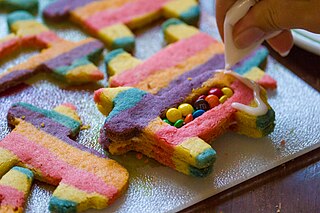
A cookie or biscuit is a baked snack or dessert that is typically small, flat, and sweet. It usually contains flour, sugar, egg, and some type of oil, fat, or butter. It may include other ingredients such as raisins, oats, chocolate chips, or nuts.

Midwestern cuisine is a regional cuisine of the American Midwest. It draws its culinary roots most significantly from the cuisines of Central, Northern and Eastern Europe, and Indigenous cuisine of the Americas, and is influenced by regionally and locally grown foodstuffs and cultural diversity.

New England cuisine is an American cuisine which originated in the New England region of the United States, and traces its roots to traditional English cuisine and Native American cuisine of the Abenaki, Narragansett, Niantic, Wabanaki, Wampanoag, and other native peoples. It also includes influences from Irish, French, Italian, and Portuguese cuisine, among others. It is characterized by extensive use of potatoes, beans, dairy products and seafood, resulting from its historical reliance on its seaports and fishing industry. Corn, the major crop historically grown by Native American tribes in New England, continues to be grown in all New England states, primarily as sweet corn although flint corn is grown as well. It is traditionally used in hasty puddings, cornbreads and corn chowders.

Cake is a flour confection made from flour, sugar, and other ingredients and is usually baked. In their oldest forms, cakes were modifications of bread, but cakes now cover a wide range of preparations that can be simple or elaborate and which share features with desserts such as pastries, meringues, custards, and pies.

Gooey butter cake is a type of cake traditionally made in St. Louis, Missouri. It is a flat and dense cake made with wheat cake flour, butter, sugar, and eggs, typically near an inch tall, and dusted with powdered sugar. While sweet and rich, it is somewhat firm, and is able to be cut into pieces similarly to a brownie. Gooey butter cake is generally served as a type of coffee cake and not as a formal dessert cake. There are two distinct variants of the cake: the original St. Louis, MO Bakers' gooey butter and a cream cheese and commercial yellow cake mix variant. The original St. Louis, MO Bakers' gooey butter is believed to have originated in the 1930s. It was made with a yeast-raised sweet dough on the bottom.

Shoo-fly pie is a type of American pie made with molasses associated with Pennsylvania Dutch cuisine. While shoo-fly pie has been a staple of Moravian, Mennonite, and Amish foodways, there is scant evidence concerning its origins, and most of the folktales concerning the pie are apocryphal, including the persistent legend that the name comes from flies being attracted to the sweet filling.

Pennsylvania Dutch cuisine is the typical and traditional fare of the Pennsylvania Dutch. According to one writer, "If you had to make a short list of regions in the United States where regional food is actually consumed on a daily basis, the land of the Pennsylvania Dutch—in and around Lancaster County, Pennsylvania—would be at or near the top of that list," mainly because the area is a cultural enclave of Pennsylvania Dutch culture.

Entenmann's is an American company that manufactures baked goods and delivers them throughout the United States to supermarkets and other retailers for sale to the public. They are often known to have display cases at the end of store aisles. The company offers dessert cakes, donuts, cookies, cup cakes, loaf cakes, pies, cereal bars, muffins, Danish pastries, crumb cakes, and buns among other baked goods. In the past several years, they have added designer coffee flavors along with scented candles to their product line in an effort to broaden its appeal.

The cuisine of Philadelphia was shaped largely by the city's mixture of ethnicities, available foodstuffs and history. Certain foods have become associated with the city.

Blueberry pie is a pie with a blueberry filling. Blueberry pie is readily made because it does not require pitting or peeling of fruit. It usually has a top and bottom crust. The top crust can be circular, but the pie can also have a crumble crust or no top crust. Blueberry pies are often eaten in the summertime when blueberries are in season in the Northern hemisphere.

A cookie cake is a dessert that consists of a large cookie, which is baked similarly to a batch of regular-sized cookies and usually decorated with frosting. Cookie cakes are made with cookie dough, generally by adjusting the portions of existing cookie recipes to match the size of the pan used for baking. Cookie cakes can be baked in a variety of sizes, and are served and sliced in sections, similarly to cakes and pies.

A sandwich cookie, also known as a sandwich biscuit, is a type of cookie made from two thin cookies or medium cookies with a filling between them. Many types of fillings are used, such as cream, ganache, buttercream, chocolate, cream cheese, jam, peanut butter, lemon curd, or ice cream.

A piñata cookie is a sugar cookie that is shaped and colored like a piñata and filled with various small candies which spill out when the cookie is broken. Piñata cookies may be multicolored, which involves preparing separate batches of cookie dough and dyeing them different colors. The dough is then layered into a loaf with the various colors being separated A cookie cutter may be used to create various shapes. After the cookies are baked, they are further prepared by creating a hollow pocket, inside which the fillings are placed. They may be filled with candies, such as miniature M&Ms candy, chocolate buttons, or other ingredients. They are then sealed using frosting.

Katherine L. Ogilvie Musgrave was an American academic, registered dietitian, and nutritional consultant. She taught food science and nutrition at the University of Maine from 1969 to 1986, and after her official retirement continued teaching for close to three decades on the university's online continuing education website, educating thousands of students. During this time she also worked as a dietitian for three Bangor physicians, conducted nutrition workshops and corporate wellness programs across the state, and appeared on a weekly radio show speaking about healthy living.
Pie in American cuisine has roots in English cuisine and has evolved over centuries to adapt to American cultural tastes and ingredients. The creation of flaky pie crust shortened with lard is credited to American innovation.

Hello Robin is a woman-owned bakery with two locations in Seattle, in the U.S. state of Washington. The original bakery opened on Capitol Hill in 2013. A second location opened at University Village in 2020.














